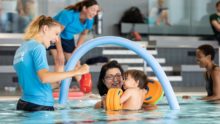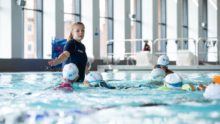
The differences between coaching and teaching
January 28, 2016 Careers AdviceThe differences between coaching and teaching are greater than you think. It’s often assumed that teachers and coaches simply convey information and knowledge to swimmers.
This is not the case. In fact, this is where the differences between coaching and teaching become apparent.
Teaching Roles
One of the differences between coaching and teaching is that teachers predominantly work with non-swimmers or those not fully confident in the water, unlike coaches. Swimming is one of few sports that needs to be taught.
Swimming does not come naturally. You need to know how to propel yourself through the water and the correct breathing techniques to use while doing this. These are skills which need to be taught.
Swimming teacher facts
- Teachers normally have around 12 participants per lesson and so able to focus on individual swimmers.
- Learning is often seen as a one-way transfer of knowledge; although the learner’s development directs the lesson structure and its outcomes.
- Teachers promote swimming for life to all, and can guide those swimmers with potential down a competitive swimming pathway.
Coaching Roles
Coaching is a very different role. Coaches impart knowledge. They also help their participants to grow and develop themselves.
Some of the differences between coaching and teaching are that coaches offer advice and guidance, and provide information that swimmers can decide whether or not to follow themselves. This is not the case with teachers.
Coaches will also provide more one-to-one time than teachers when required, focusing on the participant as a unique individual who might need completely different training and motivations than their peers.
Swimming coach facts
- ASA Level 2 Qualified Coaches and Level 1 Support Coaches work in either a competitive Talent Development or High Performance environment at registered aquatics clubs
- Coaches guide and improve the existing technical skills of the aquatic discipline they work in, including swimming and open water swimming, diving, synchronised swimming and water polo
- They create ‘coach driven-participant led environments’ where athletes decide their next step.
- Coaches can have around 30 athletes at any one training session.
- They set out the session plan including drills and recovery time relevant to the specific development phase of a training programme.
- They may concentrate less on individual attention during these sessions as most athletes will know what they have to do.
 Careers in Aquatics
Careers in Aquatics



